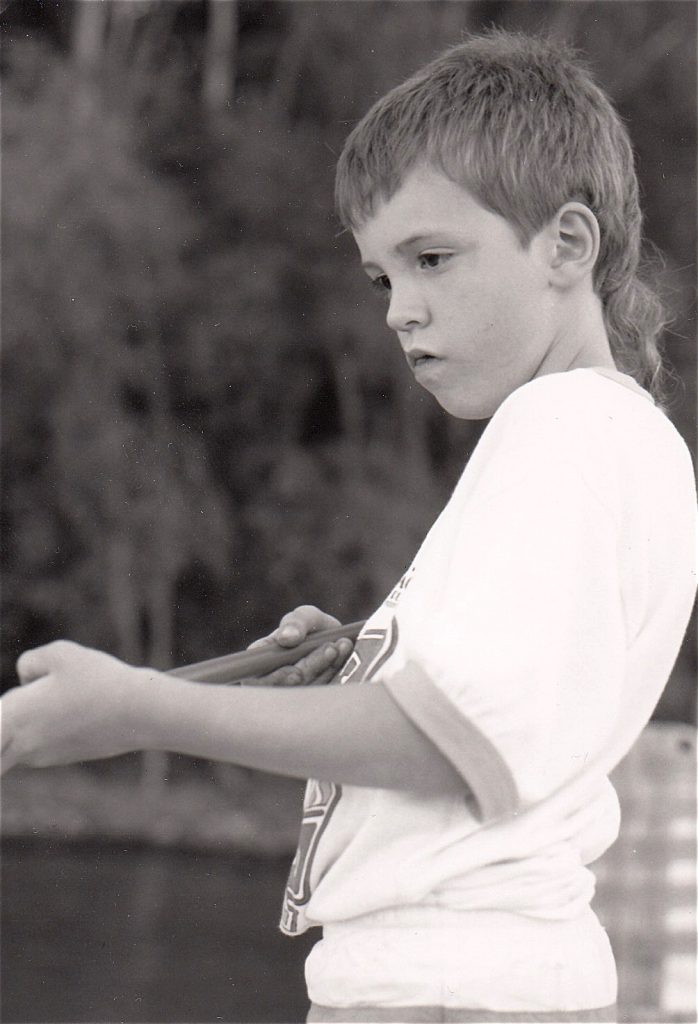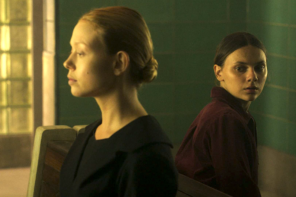When I was in fifth or sixth grade my father bought me a King James Bible. It was bound in white faux leather and embossed with gold lettering. My dad was not religious in the slightest (though he had a surprisingly large collection of books about the historical Jesus), but the children’s Bible with pastel illustrations I got from Sunday School demanded a dignified, literarily respectable replacement.
I couldn’t make much sense of King James, but I enjoyed leafing through the pages—more gold, on their edges!—and sensing some vague power in the sheer overwhelming quantity of words they contained.
I started bringing this Bible with me wherever I went—in my backpack to school, biking through my neighborhood. At my best friend’s house, we marched around his yard and the woods behind his house pretending we were preachers prophesying the end of the world. It gave me a thrilling sense of power to possess this secret knowledge that everyone else was too blind to see.
Whether as a prop in playacting or simply toted around my pre-adolescent life, having the white inscrutable Bible close at hand made me feel good. Its potency lay somewhere in the space between imaginative play, in which a transfigured stick glows into a light saber, and the grownup world of real things. I knew it was an important book a lot of people actually read, and I had a dim sense there were at least some who thought the unusual things it told and foretold were true.
The same went for the black wooden cross necklace an Episcopal priest gave me on the day I was baptized when I was 10, during a short-lived campaign my parents undertook to get our family some religion. I told the priest after the ceremony that I thought his cross looked “really cool.” He took it off at once and put it in my hand. I’ve kept it among a few choice treasures that have made it through every almost-annual move of my twenties and early thirties.
The priest had done something else unusual with a consecrated object during what must have been a baptismal preparation class. He took a one-dollar bill out of his wallet, struck a match, and lit the perfectly good, perfectly legal tender on fire. It caught flame quickly, as if it had been ready for it. The priest held it by a corner over a small metal bowl that caught the black glowing flakes of paper ash, not dropping it until the last possible second, when it looked like there was no more corner left to hold.
I can’t recall the explanation that followed the strange ritual, performed for me and maybe one or two other kids, but I remember my astonishment at his casual destruction of government property. I was deep into magic tricks at the time, sometimes carrying a deck of cards in my pocket, and I had seen magicians make coins disappear. But this was no illusion. I knew this was not only a waste, but technically illegal—one of the innumerable bits of trivia I knew about the world because of my father, who seemed to know something about everything.
My love for relics and talismans coexisted with a love for chemistry sets and circuit boards. I would ride my bike through our suburb’s streets hunting for garage sale stereos, which I would haul like a little Viking raider back to my room to pillage for parts. What the resistors, transistors, capacitors, diodes and wires were parts for, well, I was still figuring that out, but mining and collecting and imagining various useful futures for them—a powerful laser weapon or a spy listening device?—was a serious passion.
These objects also became ones I liked to hold and carry around with me.
With the religious paraphernalia they completed my cache of what psychoanalyst Donald Winnicott called “transitional objects.” Like a worn-out teddy bear, they existed somewhere between the subjective world of my imagination and the objective world of tangible people and things. Transitional objects, in Winnicott’s view, help children move from the secure but undifferentiated environment of their mother’s constant care to one where they come to exist separate from their mother and in which their desires are not immediately gratified. Such objects allow for an imagined but sincerely felt sense of the mother’s presence amidst a world that is unpredictable and from which the mother may sometimes be absent.
I’m ready to admit that my fascination with magical objects at an age beyond the developmental stage where they are typically abandoned—age three or so—could be something to wonder about. But Winnicott also had a theory of “transitional phenomena,” which he thought persisted beyond the childhood need for soothing physical objects and into adulthood. These phenomena served more or less the same function—allowing humans to inhabit the intermediate space between self and world, presence and absence, stable order and creeping chaos, and they included symbols, cultural and political projects, science and religion.
The German social theorist Max Weber claimed that one of the signal marks of modernity was a process of “disenchantment”—the systematic dwindling of mystery from our most basic frames of reference. People in traditional societies inhabited a world of fairies and sprites, demons and ghosts that acted upon humans and nature. But now a constellation of forces—ascetic Protestantism, capitalism, bureaucracy, and a kind of thinking he called “instrumental rationality”—had conspired to stage a disappearing act in which magic itself vanished from the scene.
Weber may have adapted his concept from the poet and playwright Friedrich Schiller, who lamented “de-divinization” in his poem “The Gods of Greece”: “There, where now, as we’re by sages told, / Whirls on high a soulless fiery ball, / Helios guided then his car of gold.” Schiller knew that the “sages” of modern science had discredited not only the animism and polytheism of the ancients—which saw the sun not as a giant physiochemical reaction, but as a chariot driven by a deity—but also the Christian view of nature as divine creation. He thought it was the artist’s task to shroud what had become matter’s lifeless mechanism with “the magic veil of poesy.”
My first conscious brush with disenchantment came during a junior high camping trip in northern Minnesota. I suggested to my friends that we pretend to be wizards and elves on an epic quest through the forest—and they looked at me like I had lost my mind. We were camping. The point was to find adventure by canoeing across lakes, hiking through woods, pitching tents, building fires. I tried to mask my embarrassment by playing it off as a joke. It wasn’t that I had been living in a full-time fantasy world up to that point—even small children move in and out of imaginative playfulness and mundane existence—but I had apparently held on longer than my peers to a more magic-permeable view of things.
There are many people who claim to find a sense of wonder in nature, and by the grace of growing up near fairly wild suburban woods—which can seem enormous to kids—and several more summers of camping trips, I am one of them. Even without mystical takeoff, a walk through woods or by water can slow us down and stir up awe. My post-college “spiritual quest” began with a late-night walk through the woods behind my parents’ house, and the best way I’ve found to describe that inaugural experience was that the trees looked “more real than before.” When I tried to explain this—and the sense that everything felt more real, including my self—to my college girlfriend, she looked at me with the same scrunched, doubting brow my friends had on that canoe trip years before.
And then a strange thing happened. After some time spent improvising my own idiosyncratic meditation practice incorporating a few tricks from Zen Buddhism as a means of accessing that more real place I had in the woods at night, I started to get curious about Christianity. Though first drawn, in solitary reading, to the more philosophical strands, in books by Soren Kierkegaard, Simone Weil and Paul Tillich, I began to crave something I could get my hands on, carry around, bump into. One day in a bookstore in New York I did bump into a charming community organizer with dreadlocks down to his lower back who invited me to check out a church where he was a minister-in-training. I started going regularly and eventually joined. Then I went to divinity school, and now I’m starting my own church in Chicago.
A lot happened to get me to the point of wanting to start a church, and at this point I’m in pretty deep as far as Christianity is concerned. However, something I’ve found hard to admit is that the real, physical space of the Christian church—which has become important and life-changing for me—is nonetheless full of people, stories and symbols I can still have a hard time seeing as real. I have a hunch I’m not the only one for whom this is the case.
The 2014 Pew Religious Landscape Study found a rate of attrition for Christians in the U.S. even higher than many had expected—eight percent in seven years—and among younger millennials, only 56 percent call themselves Christians (as opposed to 85 percent for their grandparents’ generation). More than a third are religiously unaffiliated, up 10 percent from 2007. Still, very few of the so-called “nones” claim the atheist label. The problem is not necessarily openness to faith, it’s that the Christian words and symbols don’t seem to be working like they used to.
What if reality and unreality are not a one or a zero, a true or false affair? What if there are degrees of reality?
Simone Weil, whose religious philosophy weaves Plato with the New Testament and shows a scrupulous concern with the material world, writes in Gravity and Grace, “The mind is not forced to believe in the existence of anything…the only organ of contact with existence is acceptance, love. That is why beauty and reality are identical. That is why joy and the sense of reality are identical.”
Her idea is that something, anything—the Bible, the cross, the person slumped over there in the café or asleep on that park bench—can become more or less real depending on the degree to which we accept them, how much we are open to loving them. She says, “Among human beings, only the existence of those we love is fully recognized.”
I’m beginning to accept the stories and symbols of Christianity without expecting they come out of the gate fully real or believable for me. I continue to harbor doubts about them. I’ve experienced them by turns as sites of wonder and as stories whose literal and historical truth I wonder about.
If God is the ultimate transitional object, occupying an intermediate space between our subjective experience and external, measurable reality, so be it. God is both transitional object and provider of the re-enchanting holding environment we all still need, the one in whom Paul says “we live, and move, and have our being.”
To live is to be in transit, moving as we do between fleeting people and moments. One option is to let the Great Big, Very Real Disappearing Act make us seek escape in the deadening pendulum swing from private anxious fantasies to external distractions. (Lest I risk succumbing to the temptation of playing the prophet with perfect vision that I discovered in adolescence, here’s where I confess, and halfheartedly repent of, my current “reality” addiction: Season 12 of “The Bachelorette”).
Another option is to trust that with repeated exposure, the signs and wonders of religion—undeniably tarnished by abuse and neglect—can become less rote, more real. And with its increasing vividness, the imagined world that takes shape inside our brains can draw us more fully out into the world of hurting, in-transit humans, who need as much real presence and attentive holding as we can pass along.






